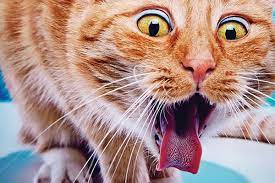Preventing Hairballs: Tips and Tricks for Cat Owners

Introduction
As a cat owner, it's almost certain you've encountered hairballs. These are small
collections of fur that your cat has ingested during grooming, which sometimes come
back up. While hairballs are a common occurrence in cats, especially those with
long fur, they can sometimes cause health issues such as obstructions in the digestive
tract. Fortunately, there are several effective strategies to reduce and prevent
hairballs. This article offers valuable tips and tricks to help your feline friend
lead a more comfortable and hairball-free life.
Understanding Hairballs
Cats are known for their meticulous grooming habits. When they groom, their tongue’s
tiny hook-like structures catch loose and dead hair, which is then swallowed. Most
of this hair passes through the digestive tract with no problem. However, some of
it can form a ball in the stomach. When the hairball becomes too big to pass, cats
usually vomit it out. Despite the name, these "balls" are often cylindrical in shape
due to the narrow esophagus they must pass through.
The Importance of Regular Grooming
Regular grooming is the most effective way to prevent hairballs. By brushing your
cat daily, especially if they have long hair, you can remove much of the loose fur
before your cat ingests it during self-grooming. Consider using a grooming tool
designed to reach the undercoat where most of the loose hair resides.
Hydration is Key
Keeping your cat well-hydrated aids in keeping the digestive system healthy and can
help hair move through the digestive tract more easily. Encourage your cat to drink
plenty of water by providing fresh water daily. You can also consider investing
in a cat water fountain, which can attract cats to drink more due to the running
water.
A Fiber-Rich Diet
A diet high in fiber can help in the prevention of hairballs by promoting better
digestion and helping to keep the gastrointestinal tract clean. Some pet food manufacturers
offer cat food specifically designed to control hairballs. These products often
contain high levels of fiber. You can also add canned pumpkin to your cat’s food
as a source of fiber, but consult with your vet first.
Hairball Remedies and Laxatives
There are numerous hairball remedies available over the counter at pet stores. These
products often come in a tube and are flavored to make them more appealing to your
cat. They work by helping the ingested hair pass through the digestive system. Laxatives
can also be used for the same purpose, but always consult your vet before giving
your cat a laxative.
Regular Vet Check-ups
Regular vet check-ups can help in preventing hairballs. Your vet can provide advice
tailored to your cat's specific needs and monitor your cat for any potential complications
related to hairballs. If your cat is frequently vomiting hairballs, it's essential
to seek veterinary advice, as this can be a sign of other health problems.
Conclusion
Hairballs are a typical part of a cat's life, but that doesn't mean they can't be
managed. Regular grooming, adequate hydration, a fiber-rich diet, and regular vet
check-ups are your best defenses against hairballs. If your cat seems to be suffering
from an excessive number of hairballs, it's important to consult with your vet.
Each cat is unique, and what works best for one might not work as well for another.
Experiment with different techniques and find what works best for your feline friend.
Remember, the health and happiness of your cat are well worth the effort.